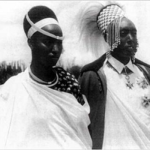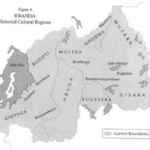Ritual as Communication: Structuralists and the Analysis of Drama
Rituals are essentially formalized social drama. They are performed by people; therefore (where not esoteric) they invariably focus attention on the social aspects of the ritual, because in the performance there is no way of ignoring the question of who is carrying out a certain action. In myth, on the other hand, the sociological meaning is not an element essential to the genre: it may be important, but it need not be so. In myth, actions can be portrayed without direct relevance to a given social situation.
The immediate relevance of ritual is also apparent in temporal considerations. The performance of ritual—or at least of rites—requires a certain organization; at the very least, people (and props) must meet together. As illustrated below, rituals directed to a conscious social goal often demand a precise temporal organization, performed at an externally defined moment (planting, harvest, birth, marriage, death, or succession). To be effective, they must adhere to pre-scribed timing, determined either by regular intervals (calendrical time) or by social, biological, or cultural rhythms that may occur at irregular intervals on a calendrical scale. Thus, by the very context of this type of ritual performance, there is a required immediacy or temporal orientation, placing the performance in a timeframe relative to the present. The immediate relevance of ritual in two domains, the temporal and the social, tends to reinforce their conceptual interrelation, thus providing temporal significance to the social patterns portrayed and reflecting the social significance of the timing of the performance.
Myth, on the other hand, often refers to the extremities of conventional time scales; it is seen as portraying events “outside of time,” speaking to the universal and eternal preoccupations of people. The timing of narration can also be more flexible than is the usual performance of a ritual: though external stimuli— seasonal, cultural, or particular (e.g., illness or misfortune)—may serve as catalysts to the recitation of a myth, such stimuli are not required as a condition of narration; myths (or mythical characters) can be alluded to at any time. Finally, myth can be more flexible in its use of actors, at times only alluding to human characterization, or employing other literary devices to free itself from the question of direct social relevance. Removed from both social and temporal immediacy, the mythical form thus most frequently addresses questions of the “beyond.”
Hence both by their nature and purpose, rituals are related to time and society in a way that myth need not be. Both these factors derive directly from the performance of the art: the power of social roles in ritual performances, on the one hand, and the very context of immediacy, on the other, may well mean that rituals will be seen in the context of present social structures more than myth. When a person of a certain status performs in a ritual, the conjunction of person and role carries a meaning for contemporary society that is more compelling than what is often present in the recital of a myth. A ritual happens; the same is not always true (or not true in the same way) for a myth.
The social aspect inherent in ritual performance highlights a particular problem of interpretation for structural analysis: as is illustrated in Lévi-Strauss’s interpretation of ritual among the Coma of Panama, a structural approach to analysis is essentially based on textual data.For Lévi-Strauss, the analytical referent is the “song”—that is, the text that describes (or directs) the ritual—rather than the ritual itself. Similarly, the analysis of Rwandan ritual presented here is based on a ritual “code”—a text that amounts virtually to a series of stage directions. Such a text is almost totally devoid of the emotions, the “sense” of the performance, and the drama of performance; for all the precision and detail found in the text, we are denied the sense of creativity—or re-creation—of the moment. Only after having thus torn out the heart of the performing art, the structuralist technique seems to say, can one proceed beyond the immediate sociological concerns to seek the ultimate (structural) meaning of the performance.
Thus the nature of the analysis depends to a large extent on the type of sources employed. The significance of the sources of analysis can be illustrated with reference to the ritual discussed below, for which there are available both a formal text and secondary descriptions (by others) based on personal observation and discussion with participants in the ritual (though the authors of such descriptions did not have access to the exotic ritual Code on which this analysis is based).The latter provide a remarkable degree of detail and a general fidelity to the ritual as an event (in its syntagmatic unfolding). But lacking access to the entire esoteric Code (and thus relying on description and observation), these observers were faced with a dilemma as they tried to portray the structure of the ritual. Because of the vast spatial and temporal dimensions included in the ritual in its entirety, such a description had to be either based on a compilation of di-verse sources dealing with different aspects of the ritual or presented from a sin-gle perspective that could encompass only part of the ritual. In either case, the structure of the ritual presented in these observer accounts differs significantly from what appears in the official Code; this leads to interpretations in the published accounts that differ in important ways from that which will emerge from the structural analysis presented below.
Most of these (colonial) observer accounts privilege the role of court and king: the former as the most prominent locus of the ritual drama (at least to the nonparticipant); the latter as the central presence in any social interaction, whether or not of a ritual nature. Because these sources are based on the perspectives of a single observer viewing only selected segments of the ritual, a selection based on contemporary (e.g. colonial) sociological concerns and because this ritual is interpreted as a ritual of the court, these accounts stress the overriding political preoccupation of colonial Rwanda—relations between Tutsi, Hutu, and Twa, the three most broadly based social identities within Rwandan society. In certain respects, such an interpretation differs markedly from an interpretation derived from the perspective of the ritual as an integrated whole used as a device for understanding the wider world around kingship. In this analysis, we intend to look through the prism of ritual to the overriding questions of human concern rather than looking at the ritual through the lenses of particular questions of the day.
Thus the textual form of the Code—a form that seems at first glance to deny the essential sense of involvement and drama of any ritual presentation— ultimately succeeds in providing the tools for (or at least the hope of) penetrating beyond drama to the structural components of what is being communicated. Drama, like lexicon, then, is a form of communication: but structure, like syntax, is what carries the meaning—at least at one level. And it is at this level that, after briefly looking at the Rwandan context, we shall attempt our analysis.
https://uk.amateka.net/ritual-as-communication-structuralists-and-the-analysis-of-drama/https://uk.amateka.net/wp-content/uploads/2022/11/yuhi-musinga.jpghttps://uk.amateka.net/wp-content/uploads/2022/11/yuhi-musinga-150x150.jpgSocial & cultureRituals are essentially formalized social drama. They are performed by people; therefore (where not esoteric) they invariably focus attention on the social aspects of the ritual, because in the performance there is no way of ignoring the question of who is carrying out a certain action. In myth, on...BarataBarata rpierre@ikaze.netAdministratorAMATEKA | HISTORY OF RWANDA



